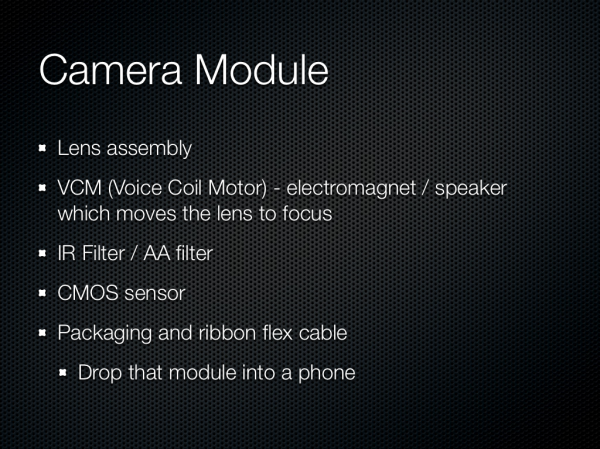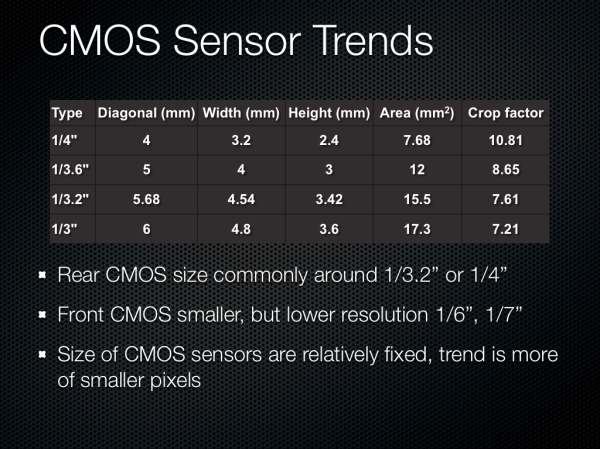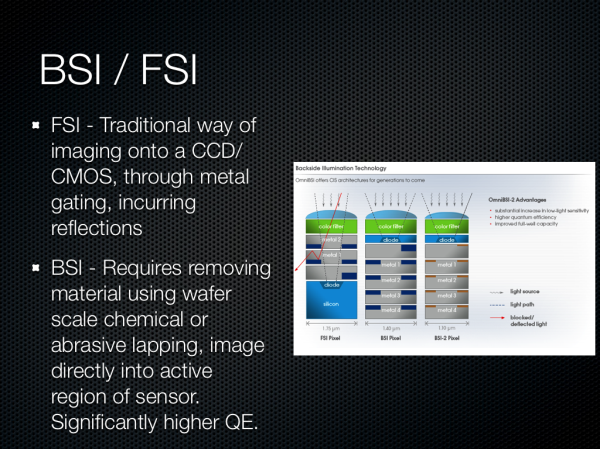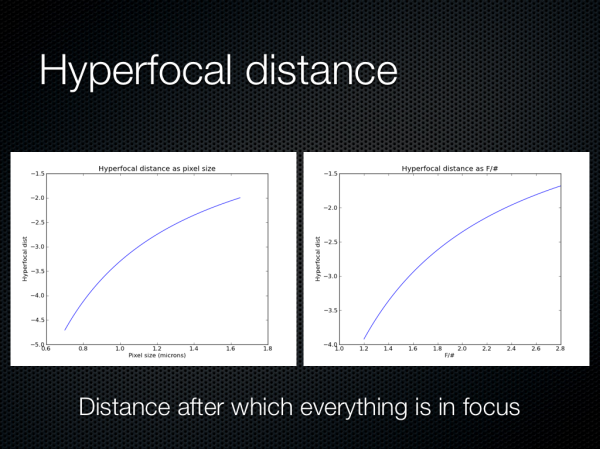Understanding Camera Optics & Smartphone Camera Trends, A Presentation by Brian Klug
by Brian Klug on February 22, 2013 5:04 PM EST- Posted in
- Smartphones
- camera
- Android
- Mobile
The Camera Module & CMOS Sensor Trends
So after we have the lenses, what does that go into? Turns out there is some standardization, and that standardization for packaging is called a module. The module consists of of course our lens system, an IR filter, voice coil motor for focusing, and finally the CMOS and fanout ribbon cable. Fancy systems with OIS will contain a more complicated VCM and also a MEMS gyro somewhere in the module.
Onto CMOS, which is of course the image sensor itself. Most smartphone CMOSes end up being between 1/4“ and 1/3” in optical format, which is pretty small. There are some outliers for sure, but at the high end this is by far the prevailing trend. Optical format is again something we need to go look at a table for or consult the manufacturer about. Front facing sensors are way smaller, unsurprisingly. The size of the CMOS in most smartphones has been relatively fixed because going to a larger sensor would necessitate a thicker optical system, thus the real trend to increase megapixels has been more of smaller pixels.
The trend in pixel size has been pretty easy to follow, with each generation going to a different size pixel to drive megapixel counts up. The current generation of modern pixels is around 1.1 microns square, basically any 13 MP smartphone is shipping 1.1 microns, like the Optimus G, and interestingly enough others are using 1.1 microns at 8 MP to drive thinner modules, like the thinner Optimus G option or Nexus 4. The previous generation of 8 MP sensors were using 1.4 micron pixels, and before that at 5 MP we were talking 1.65 or 1.75 micron pixels. Those are pretty tiny pixels, and if you stop and think about a wave of very red light at around 700nm, we’re talking about 1.5 waves with 1.1 micron pixels, around 2 waves at 1.4 microns, and so forth. There’s really not much smaller you can go, it doesn’t make sense to go smaller than one wave.
There was a lot of talk about the difference between backside (BSI) and front side illumination (FSI) for systems as well. BSI images directly through silicon into the active region of the pixel, whereas FSI images through metal layers which incur reflections and a smaller area and thus loss of light. BSI has been around for a while in the industrial and scientific field for applications wanting the highest quantum efficiency (conversion of photons to electrons), and while they were adopted in smartphone use to increase the sensitivity (quantum efficiency) of these pixels, there’s an even more important reason. With pixels this small in 2D profile (eg 1.4 x 1.4 microns) the actual geometry of a pixel began to look something like a long hallway, or very tall cylinder. The result would be quantum blur where a photon being imaged onto the surface of the pixel, converted to an electron, might not necessarily map to the appropriate active region underneath - it takes an almost random walk for some distance. In addition the numerical aperture of these pixels wouldn’t be nearly good enough for the systems they would be paired with.
Around the time I received the One X and One S last year, I finally became curious about whether we could ever see nice bokeh (blurry background) with an F/2.0 system and small pixels. While trapped on some flight somewhere, I finally got bored enough to go quantify what this would be, and a side effect of this was some question about whether an ideal, diffraction limited (no aberrations, ideal, if we had perfect optics) system could even resolve a spot the size of the pixels on these sensors.
It turns out that we can’t, really. If we look at the airy disk diameter formed from a perfect diffraction limited HTC One X or S camera system (the parameters I chose since at the time this was, and still is, the best system on paper), we get a spot size around 3.0 microns. There’s some fudge factor here since interpolation takes place thanks to there being a bayer grid atop the CMOS that then is demosaiced, more on that later, so we’re close to being at around the right size, but obviously 1.1 microns is just oversampling.
Oh, and also here are some hyperfocal distance plots as a function of pixel size and F/# for the same system. It turns out that everything is in focus pretty close to your average smartphone, so you have to be petty close to the subject to get a nice bokeh effect.


















60 Comments
View All Comments
ltcommanderdata - Saturday, February 23, 2013 - link
http://www.sony.net/SonyInfo/News/Press/201208/12-...Sony's new Exmor RS sensors use a stacked structure which places the circuit section underneath the pixel section instead of beside it which should free up more room for more pixels or larger pixels within a given sensor module area or enable smaller modules. They also add a dedicated white channel for a RGBW coding which they claim improves low light performance. Any comment on the efficacy of these techniques?
Apple has been using Sony image sensors for both the iPhone 4S and iPhone 5 so that new Sony IMX135 with 13.13MP, 1/3.06", 1.12 μm pixel sensor looks like a prime candidate for the iPhone 5S.
slatanek - Saturday, February 23, 2013 - link
Well done, Brian. At last someone trying to explain and stress how much more is there to tiny smartphone cameras than just the megapixels. A few years ago I felt like we got over it and the race was over, but now few years later the race just continues but in the smartphone realm (previously compact cameras had the same issues where ultimate picture quality was compromised just to get to a higher number of megapixels on the box). Hopefully this will change in near future, but somehow I'm afraid that were stuck with it just as with the horrible quality displays in notebooks. And it's not that people don't want good quality, it's just that the behemot companys are not willing to take the risk.Anyways, thanks for a good read.
Shftup - Saturday, February 23, 2013 - link
Brain - Well done!This is a fanatastic article. Its well written, relatively easy to understand for any layman, and most importantly makes the reader coming back for more.
jabber - Saturday, February 23, 2013 - link
....for a smartphone to give me as good a picture quality as I got from my 3.2MP Nikon from 2004.When I find one I'll be happy.
I think a lot of the phone companies need to start poaching the optics and software specialists from the camera companies. It's all very well looking at the spec lists for components but its another thing entirely to make them all work together to produce a decent picture.
In the past for me near decent cams have been ruined by over zealous compression settings (Palm Pre2) or what appears to be zero configuration of the imaging processors (Nexus4).
No one yet has tweaked every part of the chain to provide a truly viable alternative to taking a $250+ camera along instead.
Never had anything to do with megapixels IMO. It's other factors that let them down.
I reckon in another 2 years we'll have it pretty much there.
MrSpadge - Sunday, February 24, 2013 - link
Same here, my Sony DSC-W5 from 2005 or so is still way better than my smartphone. If I could get at least similar quality in a new phone that would easily make it worth 50 - 100€ more for me.Tarwin - Saturday, February 23, 2013 - link
I enjoyed the article, it cleared up some doubts I had and taught me a few new things.In light of this article I hope you go into more detail in the One review when you eventually do it. I assume you will give special attention to the c amera due to how it goes against the trend and HTC's focus on it but I also hope you mention how it fits into all this a bit for those of us who read both articles. Thanks again.
DominicG - Saturday, February 23, 2013 - link
Hi Brian,much enjoyed your intro to camera optics. However you state:
"If we look at the airy disk diameter formed from a perfect diffraction limited ... we get a spot size around 3.0 microns"
You mentioned this is a back illuminated chip so that the light is focussing in a medium of refractive index ~3.5. Therefore the wavelength of red light inside the medium is ~700/3.5 = 200nm - still much smaller than the pixel. It is a bit more complicated than this since the optical resolution is of course determined not only by the wavelength but also the numerical aperture (NA) - the light refracts at the air-silicon interface so that a beam in air at 37 deg (2omega =75deg - your example lens), becomes a beam in silicon of only 10 deg. 10 deg in silicon gives a theoretical resolution (Rayleigh condition) of 0.7microns. Anyway, did you take all these factors into account?
fokka - Sunday, February 24, 2013 - link
thanks for this insightful article, brian, that's the sort of read i i visit this site for regularly!i have to say that i expected a little more (side-) content, though, like a more thorough look at the htc one initially pictured, one of the two reasons i clicked on the article. also a comparison with nokias pureview-approach would've been nice, since it's on the complete other side of the spectrum.
but this is just to nitpick, as i enjoyed the read none the less.
StormyParis - Sunday, February 24, 2013 - link
Great articleStormyParis - Sunday, February 24, 2013 - link
Seeing the interest everyone has in good pictures, and the relatively small size and cost of the lens apparatus, wouldn't it make sense to have 2 distinct cameras on a smartphone, and coordinate them to get better image quality ?